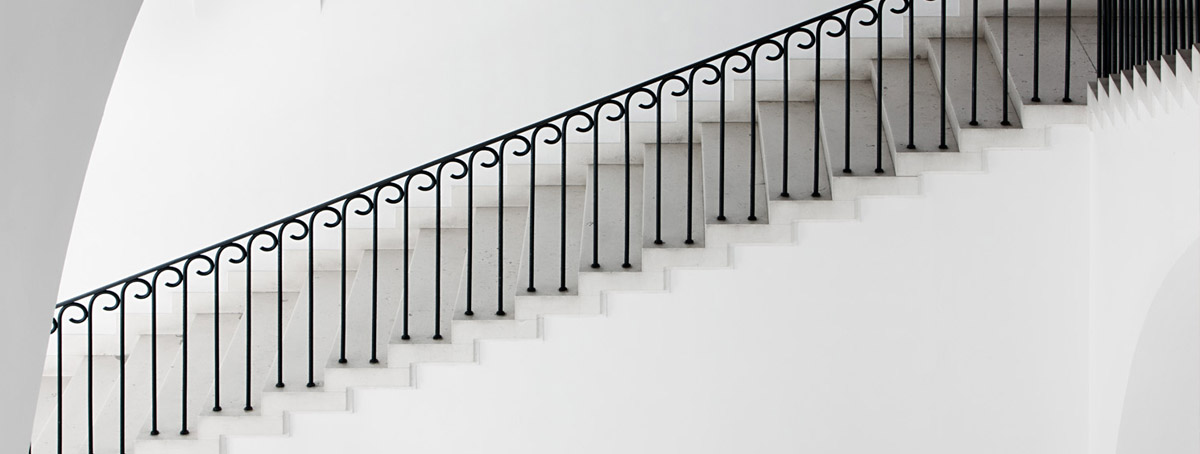ARCHIVE · 2021
DUBROVNIK COLOURISTS 1918 – 1945
- a Selection from the Collection of MOMAD
21. 12. 2021. – 30. 1. 2022.
Gallery Dulcic Masle Pulitika
Curator: Andrea Batinić
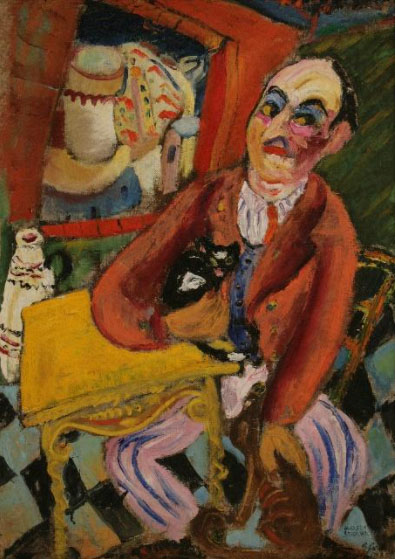
Božidar Rašica, Portret Koste Strajnića, 1935., ulje na platnu, 78 x 57 cm
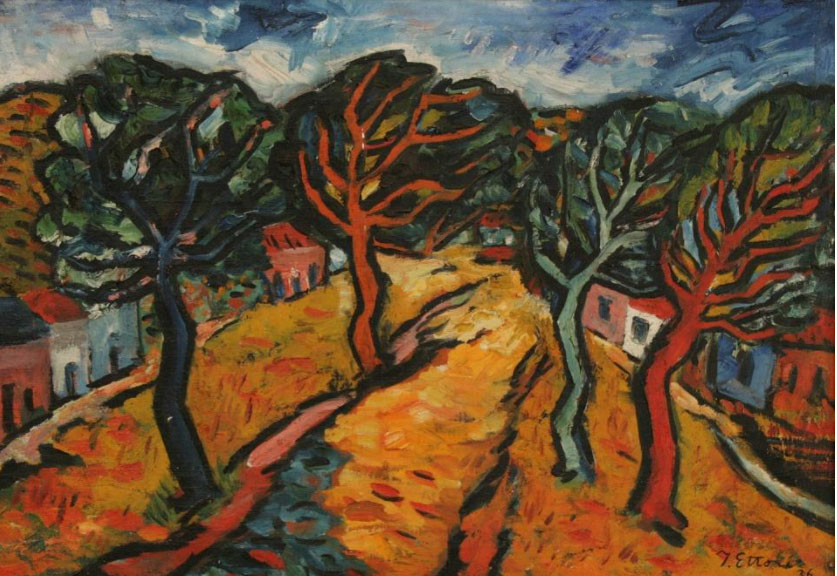
Ivan Ettore, Ulica sa četiri stabla, 1936., ulje na platnu, 48,5 x 66,3 cm
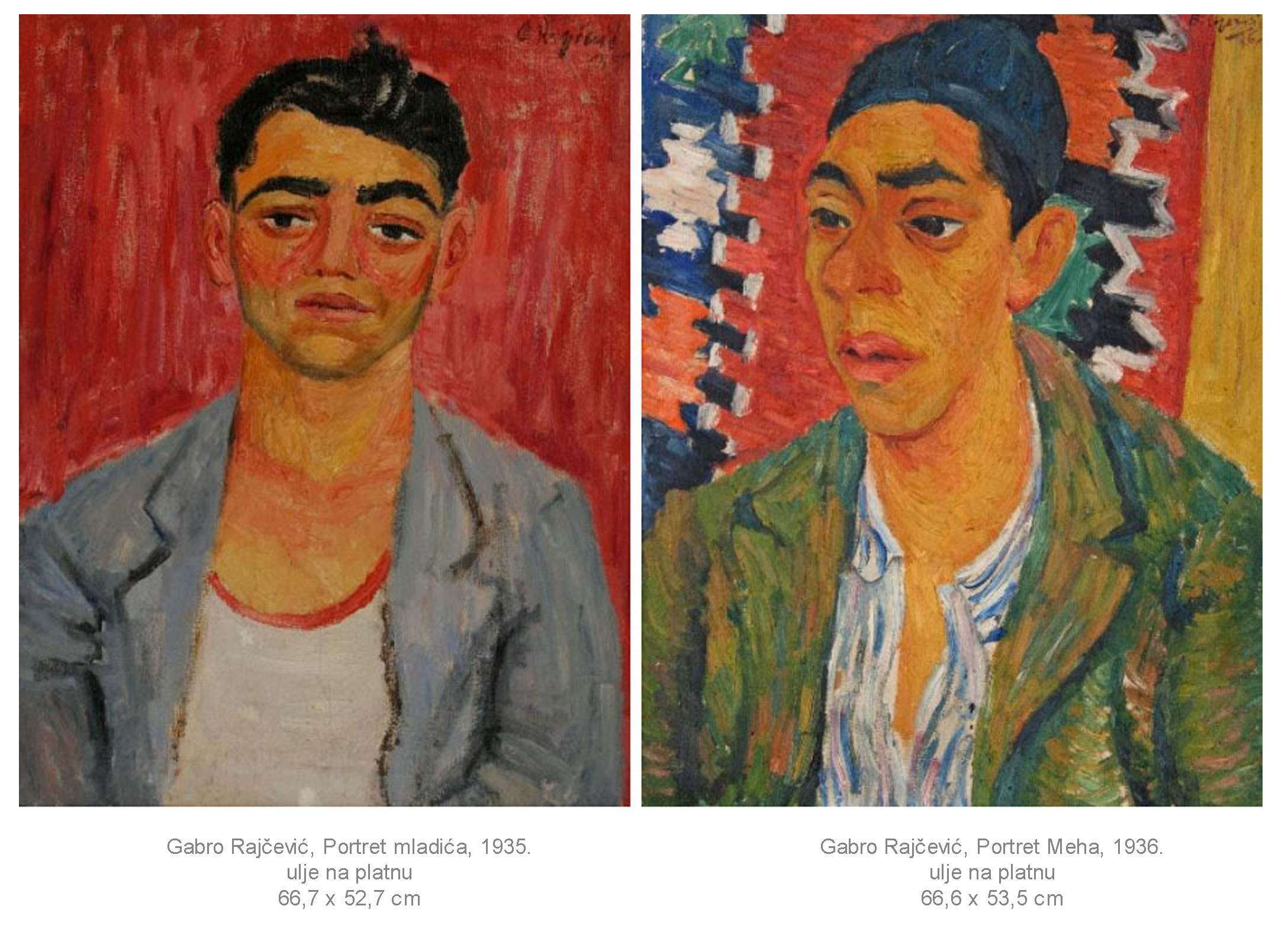
This exhibition not only formulates the specific features and particularities of the South itself, with an emphasis on the painting tendencies and events of the time, but also contains an insight into a specific feature – the Dubrovnik colourist circle –its characteristics and protagonists, and elaborates the basic characteristics of all the artists and their stylistic achievements With a selection of works from the Dubrovnik Museum of Modern Art, an analysis of individual works is conducted that tells of the stylistic productions of artists at work in the period between the two wars, with a careful emphasis on the setting in which they were formed and worked in the area of art and on the reception of individual dominant stylistic patterns of the time in which they lived. Principally there are works in which there is a considerable colourist liberation in cycles of portraits, still lifes and coastal area landscapes. By painting portraits, still lifes and landscapes filled with profoundly personal symbolism, they take us into the area of intimism and the reality of the world in which these artists lived. The Dubrovnik colourists left their mark with their paintings, which take us back to the past, to the feeling of belonging to the City and its artistic circle, while at the same time we move out into spaces of the future, where the trace of the Dubrovnik painting circle can be felt in the contemporary art of our clime.
Artists:
Gabro Rajčević (1912. – 1943.)
Ivan Ettore (1911. – 1938.)
Marko Rašica (1883. – 1963.)
Božidar Rašica (1912. – 1992.)
Niko Miljan (1891. – 1962.)
Ignjat Job (1885. - 1936.)
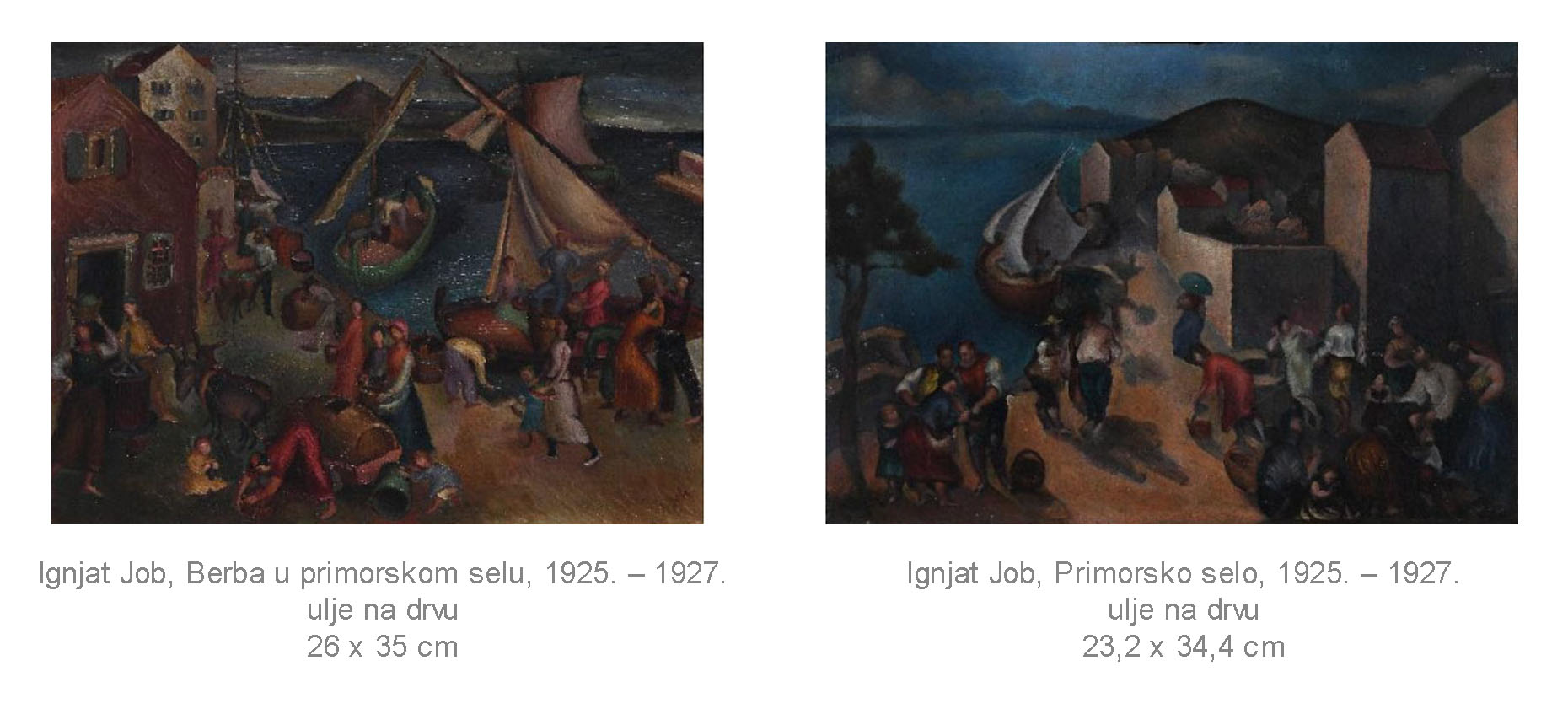
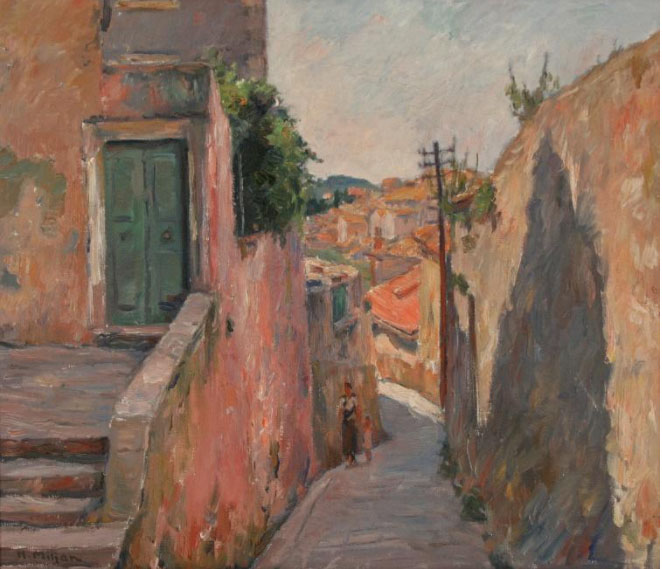
Niko Miljan, Ulica između vrta, oko 1948., ulje na platnu, 63,7 x 73 cm
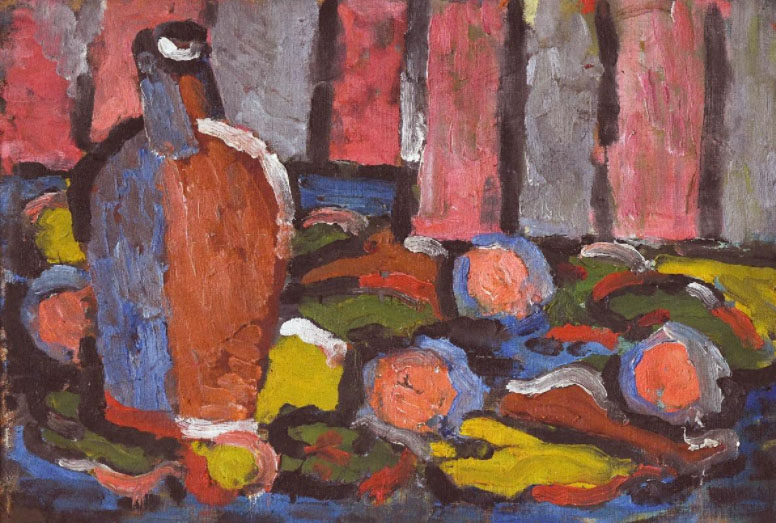
Gabro Rajčević, Mrtva priroda, 1934., ulje na platnu, 50 x 48,1 cm

Marko Rašica, Pejzaž s Lokruma, 1932., ulje na platnu, 55,5 x 68,5 cm
IVANA PEGAN _ SOMEWHERE
4.12.2021. – 30.1.2022.
Curator: Petra Golušić
Multimedia artist Ivana Pegan is represented in this exhibition by books, video works, photographs, photographs with text or typewritten words, pictures that may or may not contain writing. The idiom is built up from the world of life and the world of language the aesthetics of which is founded on the dividing line of the key questions of fundamental areas, biography, fiction and live metaphors. Pegan deals with an analysis of the conditions of the perception of space and objects and its conceptual and linguistic interdependencies. She explores the cognitive and aesthetic effects that are diverse because of the material and metaphysically structural conditions. With theoretical, philosophical and linguistic debates, she opens up specific areas of artistic work, expression and presentation. She considers the self-knowledge of the subject, and cognition. She interprets life, both realistic and imaginary, with a softness of expression of acute perception and presents it in its refractions and in its light.
Books, particularly in the visual code, have the characteristics of zen – spontaneity, simplicity, calmness and loneliness. Photographs and textual contents theoretically problematise the given or the imagined surroundings, language and mental representation. A testimony is created about imagined events and about those that are not. Authentic quotations of individual lives are linked up with codes of public and private communication and with the magic of imagination. The dignity of existence is expressed. A space that is ontologically legible is created.
 |
 |
BOOK # 3, 2018
21 x 15 x 1 cm
detail
In a series of photographic diptychs, which she directs with just a word or two, the author opens up the key issues related to the human being.
 |
 |
ONCE UPON A TIME, 2019
fine art print, typewritten characters – letters
21 x 15 cm (2 x)
The artist during her isolation in the time of the COVID-19 plague in these regions of the world created works in watercolour and gouache. The link of writing|painting the word and the picture field took place. The interpictorial and the intertextual are explored. Text is a narrative framework for the understanding of the image and in general in the work of this artist there is a philosophical relationship established between it and the visual account.
Somewhere is one of the works made up of eight images some of which also have words in them. The first part says if there is and the second no. The possibility is opened up for the existence of the real world while in the next part of the artwork there is direct consideration of the lack of existence of any such thing. After that come three abstract images that signify the limitlessness in the human, and two pieces of writing: we will and meet. The existence of the territory of encounter is announced, territory that is cancelled out as phenomenal world and is not of a material nature. This is a story of human being and the necessity of the human for the destined other. It is about the creation of an area that excludes reality and stands for zones in which spiritual expanses are the only possible place of encounter that are set us from the absolute being|absolute spirit and are necessary for continued existence. /…/ The cycle is represented by a denuded, liberated and empty landscape adduced at various levels as truth and eternal existence. It cannot be done away with or cancelled out even in the hardest|darkest periods of an individual and the world, periods in which it is simply necessary to survive.
 |
 |
SOMEWHERE, 2020
watercolor, gouache, paper
65 x 50 cm (7 x)
detail

UNTITLED, 2020
watercolor, gouache, paper
65 x 50 cm
What is going on in the work of Ivana Pegan? There is an incessant and subtle wish to arrive at the truth about the being of the world and of life, at the pith and marrow of the human being. Clearly stated is the human drive for knowledge of the transcendence, unchangeable and truthful being of everything that exists. Adduced are the dark and the light of being. Presence is analysed. Time is annulled. The perception of life in its ordinariness and quiet magnificence is mapped in simplified terms. With philosophical profundity the interior and the exterior zones which we both create and have assigned to us are connected. The imaginary is opened up. The essence of the freedom of the spirit is marked. The pure place is encoded.
 |
 |
 |
MOOD, 2017
ink, paper
50 x 65 cm (3 x)
BIOGRAPHY
Ivana Pegan was born in 1971 in Doboj. She took her degree in 1996 from the sculpture section of the Academy of Fine Arts of Zagreb University, class of Šime Vulas. In her work the artist explores and starts up various discourses through the means of audio works, video works, artist’s books, diary|books – works, photographs, installations and other things. She is a member of the Croatian Association of Independent Artists, Lazareti Art Workshop in Dubrovnik, the art organisation Tkivo and Dubrovnik Art Forum. She is the manager of the Flora Gallery of the Croatian Association of Fine Artists Dubrovnik and also works with restoration. She has exhibited at many solo and collective exhibitions and other events at home and abroad. She lives and works in Dubrovnik.
PAVO URBAN (1968. – 1991.) _ SCENES OF DARKNESS
Gallery Dulcic Masle Pulitika
16.11. – 12.12.2021.
Curator: Petra Golušić
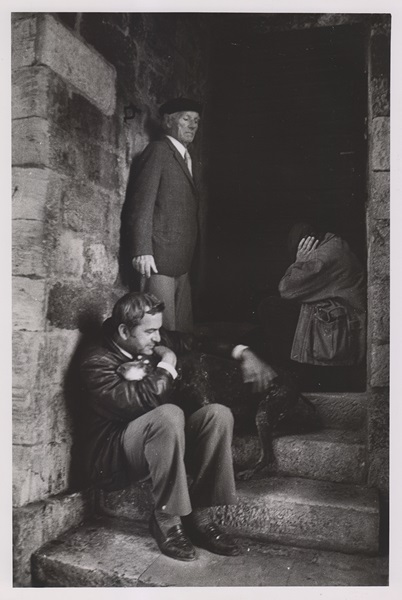
Pavo Urban bequeathed us his evidence of the horrors and terrors of the Homeland War. In his works the original truth of black and white occurs. The scenes are recorded in a balanced structure of light and framing in which harmony, order and proportion are created. The light is inscribed softly yet strongly, subtle in its description of the darkness of the contents and crucial in the documents. Humanity is preached in accounts of reality with a refined personal style. The compositions express the truth with an aesthetic quality and sharpness of insight. Sensitivity and harmony are embodied in the scenes of darkness that Urban photographs both courageously and masterfully. The artist shot scenes of loss, destruction, fear, despair, devastation, pain, suffering, shock, death. The scenes are historically vital proofs of the world; of its trauma and horror – of war. He brings to life all the three strengths or virtues that in the eyes of Barthes make up the artist: vigilance (attentiveness), wisdom and most paradoxically of all, fragility. Also featured in the exhibition are the twelve last photographs, taken on December 6, 1991, during the most ferocious attack on Dubrovnik, in the course of which the young photographer lost his life.


PAVO URBAN (Dubrovnik, 1968 – Dubrovnik, 1991) was educated at the nautical secondary school and at the Maritime Faculty in Dubrovnik. He taught himself photography in secondary school and was a member of the Dubrovnik Marin Getaldić Photo Club. In the 1990/1991 season he was the official photographer of the Marin Držić Theatre in Dubrovnik, as well as of the Dubrovnik Summer Festival in 1991. In September 1991 he got
a place to study at the Academy of Dramatic Arts in Zagreb, cinematographic and television camera major. He never started the course, nor did he pick up his student ID, for after the entrance exam and enrolment in that time he returned from Zagreb via difficult and dangerous ways to his own Town to take part in its defence. A volunteer, as early as September 29, 1991, he was on the front line in Župa dubrovačka and it was there that his photographic war oeuvre (called rat-art being Croatian for war). When Župa fell he went back to Dubrovnik and started working for the Dubrovački vjesnik and Slobodna Dalmacija as war correspondent. In this capacity he recorded the first hit on the historical core of the city on October 26, 1991. The Ministry of Information of the Republic of Croatia recruited him into a special documentation-information unit the task of which was to record on still and motion photography the destruction and devastation of Dubrovnik in the war. He performed his job extremely systematically and conscientiously. Early in the morning on December 6, 1991, he began to shoot the fiercest assault yet on Dubrovnik. And then, at the end of the dramatic series of twelve photographs shown here, he was killed, in the twenty-third year of his life. Pavo Urban is a cult name in Croatian photography and one of the symbols of wartime Dubrovnik.
DENIS KRAŠKOVIČ
MAN ANIMAL PLANT
Curator: Rozana Vojvoda
Duration: 02.10. – 28.11. 2021.
The exhibition by contemporary Croatian artist Denis Kraškovič “Man Animal Plant” covers, in terms of theme, almost all the pieces presented, from the earliest of the mid-nineties to recent works done last years. It is suggestive of the broad vision, the aspiration to cover the whole, the artist’s interest in the intertwining of the manifestations of life on the planet that is their common home.

Denis Kraškovič, Man Animal Plant, 2001, acrylic on canvas, 120 x 400 cm
Denis Kraškovič, an academy-trained sculptor, through a speciously simple expression, captures complex themes, and equally intensely and passionately uses a whole range of media of artistic expression. Apart from sculptures and sculptural groups, the exhibition also shows paintings, drawings and video works.

Denis Kraškovič, A Blue Envelope, 2018., acrylic on canvas, 80 x 120 cm
Kraškovič’s emblematic motif, the trademark of his work in sculpture, consists of animals, in the depictions of which he very seldom departs from the mimetic principle; he insists they be identifiable, with the addition of vigorous and always solid colour.

Denis Kraškovič, Close to the End, 2018, coloured epoxy resin, height: 80 cm, photo: Miho Skvrce

Denis Kraškovič, St. Francis talking to animals, 2010., coloured polyester, height: 140 cm, photo: Miho Skvrce
Another important feature of this artist’s creative work, apart from his continuous fascination with animals and the environment is self-referentiality, particularly visible in the paintings, dominated by strong, solid colours, flatness in the composition and comic-strip aesthetics.

Denis Kraškovič, Oh My Robot, if Only You and Me Could Be This Free, acrylic on canvas, 120 x 80 cm
The oeuvre of drawings of Denis Kraškovič has in it something of the diary entry, of meditational reading, it is multifarious and diverse in charge, technique and manner, the only thing running through the drawings in common is an impassioned and continuous celebration
of life.

La Dolce Vita, 2014., felt pen on paper, 30 x 21 cm

Man and the Forces of Nature, 1993, felt pen on paper, 30 x 21 cm
Denis Kraškovič genuinely, more than all other artists who came to maturity in the Croatian art scene in the mid-nineties, through a simple idiom combines very various areas – including in a specific manner both a religious and a spiritual component, plays with references to comic strips, SF films, music, delves deeply into questions of identity and at the same time takes up burning issues like concern for the environment and the extinction of plant and animal species.

Save the Threatened Mushroom, 2006., painted polyester, 600 x 600 x 50 cm
BIOGRAPHY
Denis Krašković was born in 1972 in Zagreb, where he graduated from the secondary School for Applied Art and Design. In 1994 he took his degree at the sculptural section of the Academy of Fine Arts in Zagreb, class of Stanko Jančić. In 2011 he completed a master’s degree in sculpture at the Academy of Fine Arts in Ljubljana, supervised by Jože Barši. He started his work in education at the School of Applied Art and Design in Zagreb teaching in the sculpture department from 1996 to 2007. From 2007 to 2017 he was teaching at the Academy of Fine Arts in Osijek (assistant professor and since 2013 an associate professor).
In 2015 and 2016 he was a visiting professor at the sculpture department of the Academy for Music and Visual Art in Pecs. He has exhibited in many solo and collective shows in Croatia and abroad. He is the author of sixteen public sculptures, the best known of which are Whale at Jarun Lake, Zagreb; Walrus and Lamb in front of Arena Zagreb; two monumental sculptures, Neanderthal in Krapina and Mediterranean Monk Seal and Pup in Šibenik. He lives and works as a freelance artist in Zagreb.
------------------------
EUGEN VARZIĆ
ALL YOUR PAINTINGS ARE OK
Curator: Vinicije B. Lupis
Curator coordinator: Andrea Batinić Ivanković
Duration: 22.7.2021. – 19.9.2021.

MERJEMA, 2020.
oil on canvas
150 x 200 cm
Painter Eugen Varzić in the exhibition “All your paintings are OK” introduces himself with the artwork created in the period from 2016-2021. These are paintings created in oil on canvas technique and drawings in pencil on paper technique. Artist’s wife Romana and their children and acquaintances, are being permanent models transformed into the new imaginary worlds-portraits. With such a marvellous art technique on which many are envious, painter Varzić with the completeness of his portraits has set new canons of postmodern iconography.

FUTURE, 2020.
oil on canvas
120 x 100 cm
The painter Eugen Varzić is a particular personality in the Croatian art scene for he has directed his growth in visual art, the path of his artistic research, in a different direction. We are dealing here with the building of the visual art of a contemporary Croatian painter on the heritage of the current visual trends of American painting of the 20th century. Here we are not talking about illusion, the magical need for the reproduction of reality, but of giving new meanings to the persons and objects that surround us in everyday life. (Vinicije B. Lupis)

BELLA, CIAO, 2021.
oil on canvas
200 x 130 cm
The series of portraits of his own family, of acquaintances, suggests a lasting interest in the process of examining private life, for in conversation with the model, the artist can shape a creative interrelationship. Painting is in fact Varzić’s diary, a constant fight with the whiteness of the canvas and a search for new challenges. He has thus opened a new chapter of Croatian contemporary painting, in a completely separate direction. With his independent development, inherent in himself, he took it off into the course of American art, and is surrounded by friends, absorbing the best of European experience, achieved a painterly technique worthy of the Old Masters. (Vinicije B. Lupis)

YOHANAN HA'MATBIL, 2021.
oil on canvas
200 x 180 cm
Landscape in Eugen Varzic’ painting is not just recording and transformation more or less picturesque motifs of nature, but also the theme through which he expresses his thoughts and moods. It is the sum of facts and questions; immediate experience and reflection of the accumulated experience. The artist has created coherent system of intimate landscapes or dynamic sights; hence Eugen's realism is immersion in the mystery of nature, a new creation, and this can only be attained only by the painter of top artistry, sensitive to all those harmonies in the inconceivable whimsy of changeable nature. (Andrea Batinić Ivanković)

BABINA GREDA, 2016/2017.
oil on canvas
140 x 120 cm

LIFE, 2020/2021.
Oil on canvas
150 x 70 cm
BIOGRAPHY
Eugen Varzić graduated from the painting department of the Academy of Applied Arts in Rijeka in 1999. He has shown his work at some thirty solo exhibitions and at more than a hundred collective reviews at home and abroad. He did further studies in art in Madrid, in the workshop of Eloy Morales and Antonio López Garcia. His artworks are to be found in many private and public spaces and in private collections in Croatia and worldwide, as well as in religious premises. He is the author of two public sculptures done in mosaic, Three Seater and Confine, erected in Poreč, and the mural Marino Cetina in Umag. For a number of years he has taken part in benefit auctions of paintings. Occasionally he engages in design, short films, illustration and picture book making, running art workshops ant tutoring future students of art academies. A freelance artist, he lives and works in Istria, Croatia.
---------------------------
NIKOLINA ŠIMUNOVIĆ
LAPIS LAZULI
Curator: Anita Ruso
Curator coordinator: Andrea Batinić Ivanković
Duration: 27.5.2021. – 18.7.2021.

In the “Lapis lazuli“ exhibition, Nikolina Šimunović presents herself with recent artwork and several earlier works through media of painting, sculpture, mobile, and installation. All works of art are born out of current social circumstances and connected to the historical influences of the day. Sometimes they reflect the turbulent or golden times around the artist, and sometimes the inner world of their own creator. (Anita Ruso)

SPACES OF THE TIME, 2019.
mixed media on canvas
200 x 450 cm
On the surface of her canvas, (450 cm x 430 cm) an array of different compositions rises up. Made up of miniature drawings, tracing paper, see-through organdy, tulle woven with thread and wool that binds all these different materials into a perfect union that merges in the depth of her blue. All the might of the color blue that Nikolina use sin her works of art i san unconscious side effect along with active manifestation of oceanic and sky-like surfaces. (Anita Ruso)

I OWE YOU THAT YOU DISCOVER ME - DIPTYCH, 2021.
mixed media on canvas
70 x 140 cm
The author does not deal here primarily with the structure of an individual form, but with the kind of spacial organization reduced to the relations of colour and structure, elements that bear the primarily features of the sculptural process and the expressiveness of the painter's style. By interesting framing, Simunovic creates dynamic spatial compositions, emphasizing, balancing and harmonizing them by her tactile movement. By activating surface this way, she introduces new dimension – dimension of three-dimensionality. (Andrea Batinić Ivanković)

I SEE EVERYTHING, 2021.
glass
30,8 x 35 x 12,5 cm
The airy, branched structure of epoxy resin mobile is designed as a unique spatial installation that is just a mission of the sky blue revealing the whole spectrum of sensations to an observer. This is an artwork in which, under the artist's hand, a perfect balance between the linear structure and the painted, clear surfaces is accomplished. Along with the spatial installation of the mobile, there are mirrors that achieve special aura of ethereal atmosphere by reflecting light, although their basic effect is actually autonomous, deeply plastic and mostly of very small dimensions. (Andrea Batinić Ivanković)

EVERYTHING LEADS BACK TO MYSELF, 2021.
mixed media / mobile
150 x 100 x 200 cm

EVERYTHING LEADS BACK TO MYSELF, 2021.
mixed media / mobile
150 x 100 x 200 cm
detail
BIOGRAPHY
Nikolina Šimunović was born on September 9th, 1978 in Dubrovnik, Croatia. She graduated from Luka Sorkočević Art School of Dubrovnik (secondary education) in 1997 majoring in fine art and design. She went on to study art at the Fine Arts Academy in Zagreb where she graduated in the class of 2003. She has been a member of the Croatian Association of Artists since 2004. In addition to painting, she has also been using a number other art forms, techniques, and media, applying them in illustrations, interior design and constructing various objects (such as sculptures, furniture, lighting fixtures etc.). Since 2005, she has been working as an art teacher at the grof Janko Drašković elementary school in Zagreb. In 2006, she started working as an expert associate at Sirius, center for psyhhological counselling, educational training and research. Her works can be found in private collections all over the world, as well as in various museums in Croatia.
A FRAGILITY AND STRENGTH OF A WOMAN
19.3.2021. - 31.5.2021.
Curator: Andrea Batinić
Gallery Dulcic Masle Pulitika
.jpg)
.jpg)
Sophisticated, sensible and elegant sculptures of women, girls and their bodies in the works of Croatian sculptors represented at the recent exhibition speak fully from a perspective of perception, but from narration too.
The delicate, linear structures of female bodies possess clearly-stated metaphorical- symbolic meanings. Their bodies seem to derive from the anthroposophy of Rudolf Steiner, and these are: physical, ethereal, astral and spiritual bodies. Female structures in their interpretation are in certain states. These are lonely and anxious women, almost static and simple in a kind of a minimal movement, drawn into some oneiric inner world of theirs. Imposted female figures of a young, sensual body are naked and asthenic, with the emphasized erotic corporeality. With their self-denial, purity, sensuality and fragility they unite the fundamental female essence – her inner strength; the strength that keeps her going on even when she is not capable to do so; the energy and the beating state of mind with which she maintains self-control even when it is most difficult for her and when she is overwhelmed by the fear of the unknown and the unpredictable.
The different stylistic and discursive affiliation of the exhibited sculptures, as well as the individual approaches to the theme, overlapping in certain segments, and united in the unique exhibited collection, make the former interesting and dynamic. The opus of the selected sculptures exudes special aura of ethereal radiation, although their basic effect is very much autonomous and core monumental. The surface of the sculptures is simple but layered, vulnerably exposed in a certain way but warm at the same time, it attracts and does not repel with these, and it is not cold as it often is in its smoothness and sharpness. The sculptures are liberated from the flat narration, while the power of expression finds its foothold in the composition (movement, eroticism). The depictions of women and the female body almost burst with different degrees of emotion and passion, and act on us with its meditative purity and noble innocence of the spirit that emanates from them.
The depictions of women and the female body in the works of Ivan Lozica are expressive, erotically naturalistic and they incline to the feminine sensibility, tenderness and a kind of spirituality that permeate each of his sculptures. The artist's true gift resulted in a rare expressiveness, purity of vision, melodic modelling and unwavering staticity of his figures.
There is so much immanent beauty and tightness in that „ feminine note“ that the ideas of purism and reduction are just being imposed. The reduction of form and beauty of pure lines is also visible in the sculpture „Concern“ of Frano Krsinic which in an elegant manner simplifies female figure with a tendency toward symbolic expression which simultaneously expresses the woman's fragility and strength.
Thematically, dimensionally and volumetrically, the female figure of Djordje Oraovac is similarly treated, which achieves the harmony and elegance of the line with simple transitions, bulges and depressions.
With the special sense of harmony and beauty, Nikola Njiric embodies the eroticism of form in a bronze sculpture of a woman’s torso with visible, reduced and purified elements, thus approaching the modern understanding of the sculptural form.
In his „Female planter“, Robert Franges Mihanovic synthesized realistic, secessionist, symbolic artistic expression. The woman in the bent position, in addition to being performed in a realistic manner with accentuated lines, is also fixed as much in the morphological as in the psychological form.
The naked female statues of Kosta Angela Radovani exude full, mature curves of cubist shapes, robustly executed with unwavering staticity and fluid frontality. With the refined sense of simple, organic mass of concise artistic details, he synthesizes his figures by which he expresses a woman's strength and power.
.jpg)
.jpg)
AN INSIGHT INTO THE MOVEMENTS - artworks from the MOMAD collection
Duration: March 3, 2021 - May 2021
Curators: Rozana Vojvoda & Petra Golušić & Jelena Tamindžija
Exhibition from the collection of the Museum of Modern Art Dubrovnik presents a selection from the gallery’s collection that today counts over 2,700 works of art, covering the period from the late 19th century to the present. The three floors of the Villa Banac, one of the most beautiful buildings of Croatian modern architecture, are packed with works of art that include reflections of Impressionism, Expressionistic and Coloristic tendencies, abstract expression of the organic and geometric type of the fifties and sixties, postmodern painting tendencies of the eighties and art of expanded media that includes photography, video, and performing arts.





ARTISTS:
1st floor:
Robert Farber, Jan Fabre, Steve McCurry, Slaven Tolj, Božidar Jurjević, Pasko Burđelez, Dubravka Lošić, Katarina Ivanišin Kardum, Ivana Pegan Baće, Ana Opalić, Marko Ercegović, Mara Bratoš, Ivona Vlašić, Ivana Dražić Selmani, Tina Gverović, Ivan Skvrce, Ivona Šimunović
2nd floor:
Oton Gliha, Frano Šimunović, Albert Kinert, Ivo Šebalj, Zlatko Prica, Edo Murtić, Vatroslav Kuliš, Vojin Bakić, Dušan Džamonja, Lukša Peko, Marojica Mitrović, Josip Škerlj, Milovan Stanić, Krsto Hegedušić, Ferdinand Kulmer, Jadranka Fatur, Vlado Jakelić
3rd floor:
Ignjat Job, Ivan Ettore, Gabro Rajčević, Ivo Dulčić, Antun Masle, Đuro Pulitika, Ivo Vojvodić, Josip Trostmann, Viktor Šerbu, Tomislav Gusić, Niko Miljan, Marko Rašica, Marko Murat, Emanuel Vidovića, Marino Tartaglia, Menci Klement Crnčić, Miroslav Kraljević, Vladimir Becić, Vilko Gecan, Milivoj Uzelac, Vladimir Babić, Vlaho Bukovac, Mato Celestin Medović, Josip Colonna
KATARINA ALAMAT KUSIJANOVIĆ
MENSURA
Duration: December 17, 2020 - February 28th, 2021
Curator: Petra Golušić
In an arch in the Sponza Palace, there is a Latin elegiac couplet:
Fallere nostra vetant et falli pondera meqve
Pondero cvm merces, ponderat ipse Devs
Our weights will not permit us to deceive or be deceived,
While I weigh the goods, God himself is weighing me.
.jpg)
Katarina Alamat Kusijanović uses these lines in a series of works and writes them out, cut up, i.e., fragmented, in works done in chalk on panel and in acrylic on Perspex. She reveals it in full only in two places, in the exhibition entitled Mensura, that is, measure.
Conditions for a perceptual failure to recognise the textual message are created, and this message becomes the starting point for and central motif of the works in which various universal problem areas of humanity, contemporary society, cities and places of the world, morality, freedom, truth are considered.
The modules are regularly and simply set up as frames of a polysemic saying interpreted disjointedly. It is at once endorsed and the reality is indicated in which the cancellation of its meaning, essence and existence unfolds.
Dubrovnik is the point of departure from which the motif is borrowed, so as to be able to use it to label and understand the condition of darkness and corruption of the spirit to which it has been brought, as have other cities in the world.
There is no noise and no strained emotion in the work of Alamat Kusijanović. It is simply and clearly critical without being condemnatory. What is presented is the ethical and cosmological vision that has come down from the inherited cultural heritage of the surroundings. The commercial policy of the Dubrovnik Republic had its own inscription that warned the measurers to be careful not to make mistakes, which is today particularly needful in all spheres of human work and activity. Commerce is today a mainly sullied space where horrors take place and the victim is human. Naturally there are scales that do not cheat and that in their calling are guided by the cause and point of everything that exists. Dubrovnik is made the subject, as a common place of the world, which suffers contemporary errors and which should be directed to correctness in order to justify all the qualities that were created in the past and that are suppressed in the present.
The universality of the work of the human being rests and is founded upon a renunciation of the self in the sense of surrender to the eternal which alone is truthful. Internal presence is demanding and is the basic task of every person; it is the possibility of being in truth, freedom, peace, purity… The measures are distorted at every level, it is concluded quietly and acutely and with great refinement in the works of Alamat Kusijanović.
The exhibition tells us of the collapse of the world and optimistically encodes the territory of the immortal.
.jpg)
MENSURA # 1, 2016
kreda, zlato, drvo, pleksiglas / chalk, gold, wood, plexiglass
53 x 53 x 11 cm
BIOGRAPHY
Katarina Alamat Kusijanović was born in Dubrovnik in 1965. She took a degree at the Education College in Belgrade, 1989, in the easel painting restoration and conservation section, and then in the Art Academy in Split in 2004. She has been a member of HDLU, the Croatian Artists Association, since 1992. From 1993 to 2019 she was employed as conservation/restoration adviser in the Croatian Conservation Institute and from 2008 to 2014 she was manager of the Dubrovnik Restoration Department. As staff member of the Croatian Conservation Institute she gave a series of lectures in professional and scholarly conferences at home and abroad. She has published two scholarly and a number of specialised works. She was the author of the exhibition installation Hidden Trecento (in front of the Rector’s Palace in Dubrovnik in 2018) and of the exhibition The Altar Painting of Jacopo Tintoretto from the Cathedral in Korčula (Rector’s Palace, Dubrovnik, 2008). Since 2008 she has worked as designer in the Adriatic Luxury Hotels group. She has exhibited at many solo and collective exhibitions. Katarina Alamat Kusijanović lives and works in Dubrovnik.
.jpg)
REFLEXIO CAERULEA # 2, 2020
akrilik, pleksiglas / acrylic, plexiglass
30 x 30 x 4 cm (48 x)
LOVRO ARTUKOVIĆ
DECELERATION
Duration: December 10, 2020 – February 28th, 2021
Organizers: The Art Pavilion in Zagreb and Museum of Modern Art Dubrovnik
In association with the Modern Gallery, Zagreb
Expert conception, selection of works, catalogue essay: Leonida Kovač
Curator in Dubrovnik: Jelena Tamindžija
 Biće iz bajke-kubističko, 2018., foto Gunter Lepkowski
Biće iz bajke-kubističko, 2018., foto Gunter Lepkowski
The Art Pavilion in Zagreb and Museum of Modern Art Dubrovnik are the joint organizers of the exhibition Deceleration in which, after many years, Lovro Artuković is presenting himself in Zagreb.
The exhibition should have been held in Zagreb in the Art Pavilion from mid-July to mid-September 2020, in the general framework of the cycle Ambiental Exhibitions of Contemporary Croatian Artists for the Art Pavilion. In the meantime, Zagreb was hit by the earthquake, which inflicted great damage on the Art Pavilion, because of which the gallery is closed until further notice. Therefore the exhibition is now on display in Zagreb at the Modern Gallery, for which we are most grateful to its director, Branko Franceschi.
Lovro Artuković has lived for years in Berlin, and had his last show in Zagreb in 2014 in Lauba. Since then in Zagreb, his native town, we have not had the chance to see works by this artist.
Artuković’s primary medium is figurative painting. In the creation of his works he uses the traditional technique of oil paint on large format canvases. This exhibition, too, includes large-sized paintings, but there are some new elements as well, related to the artist’s explorations in visual art. This has resulted in the great richness of detail in his recent works. The exhibition in Zagreb, and subsequently in Dubrovnik, is presenting 43 works created in the period from 2015 to 2020, and is divided into four sections: Golden Foils and Reflections; The Melancholy of Night Lights; Visit to the Studio; Excursion.
From the list of Artuković’s solo shows it can be seen that the painter exhibits but seldom and that his creative process is very lengthy, the works ultimately coming into being over a rather long period of time. Certainly, this artist cannot be accused of hyper-production, and he says of himself, quite to the contrary: “Big production is something that is completely unknown to me, I cannot create in that way”.
 Haljina na cvjetove, 2019., foto Gunter Lepkowski
Haljina na cvjetove, 2019., foto Gunter Lepkowski
Lovro Artuković says about the title of the exhibition Slowing Down and also about his recent work:
“In the last few years I’ve been living in an incessant internal struggle. The fact is that my paintings, or the things I want to achieve with them, are taking up more and more time. I think one doesn’t need to find the reason in my getting older and generally slowing down, rather in the multiplication of details in the paintings, while the manner in which I paint – the countless applications of transparent paint in a single place so that I can obtain the presence and the density of what is painted that I want – takes hours and hours that just slip by imperceptibly. Seated for days in front of the same painting, enslaved to just a single detail, I often think that I ought to speed my painting procedure up, be more productive, work in key with the age in which everything unfolds at a frenzied speed, an age in which, I’m afraid, nobody anyway is going to have the patience or the concentration to engage in looking at my pictures with a slow, old-fashioned kind of pleasure.
Actually, I have got myself into this trap, as it sometimes seems to me. I have permitted the circumstances of life, and not some plan or system, to guide me in the choice of subjects, But when I look at what I have painted, I see that it had to be painted in just that way. For the sake of energy, of the atmosphere, for the sake of everything that I wanted, consciously or unconsciously, to achieve with each of these paintings. Since I haven’t (yet) invented a patent to permit me to paint simply and rapidly, while also being content with what is painted, at the end I always humbly acknowledge this slow and painful manner, even if it sometimes frustrates me, as my personal and identifiable manner. And so I decided to exhibit the paintings done in the last few years under the title Slowing Down.”
BIOGRAPHY
Lovro Artuković was born in 1959 in Zagreb, Croatia, and took his art degree at the Academy of Fine Arts in the same city. He has developed his painterly idiom, which is based on figuration and intimism, primarily on the iconography of urban civilisation. For some years he worked as a teacher at the Applied Art and Design School in Zagreb, subsequently, for nine years, being employed as assistant professor at the Academy of Fine Arts in Zagreb. In 2003, he moved to Berlin, where he makes his living as a freelance artist. He has had numerous one-man shows. He had his first solo exhibition in 1985 in the Vladimir Nazor Gallery. In 2008 he had a retrospective in Klovićevi dvori Gallery, entitled Best Paintings, which encompassed works done between 1984 and 2008. This exhibition was accompanied by an extensive catalogue of his works also entitled Best Paintings authored by Blaženka Perica (Klovićevi dvori Gallery, Zagreb, 2008). In 2001 he received the Annual Prize of the Croatian Artists Association, and in 2013 the Prize of the Public at the exhibition Macht Kunst, in the Deutsche Bank KunstHalle.
Several distinguished art historians and critics have written of Artuković’s oeuvre, including Krešimir Purgar, Feđa Vukić, Leonida Kovač and Blaženka Perica . Two films have been made about it: the experimental film Theft directed by Lukas Nola of 2004, and the documentary L.A. Unfinished by Igor Mirković of 2008. His works are to be found in numerous public and private collections at home and abroad.
, 2020. Foto Gunter Lepkowski.jpg) Ukazanje u Neukollnu (crveno, žuto, zeleno), 2020., foto Gunter Lepkowski
Ukazanje u Neukollnu (crveno, žuto, zeleno), 2020., foto Gunter Lepkowski
MATO CELESTIN MEDOVIĆ
Exhibition marking the centenary of artist’s death
/from the MOMAD collection
Duration: 22.10.2020.-31.1.2020.
Curator: Rozana Vojvoda
South-westerly, around 1906., oil on cardboard
The Collection of Dubrovnik Museum of Modern Art holds thirty-four works1 by Mato Celestin Medović – on the whole portraits, some works with religious subjects, and landscapes, as well as various sketches and studies. Some of the works from the collection are reckoned to be among the finest that Medović created. The generic diversity that characterises Medović’s works in the Museum of Modern Art in Dubrovnik reflects, in fact, something that has never been sufficiently accentuated – that Medović was an artist who produced works of great quality in various fields of activity – in history painting, and in the religious, portrait and landscape genres.
Rozana Vojvoda
Motif from Pelješac, 1906. – 1908., oil on cardboard
BIOGRAPHY
Mato Celestin Medović was born on November 17, 1857 in Kuna, a village on the peninsula of Pelješac. After a year of education at the Franciscan Monastery of Our Lady of Loreto (Delorita) on Pelješac, in 1868 he left for the monastery of the Minorites in Dubrovnik, where he entered the novitiate. There, he started doing drawings and painting in oil, and in 1880 went off to study painting in Italy. He had private lessons in Rome from 1880 to 1882 (Ludwig Seitz, Francesco Grandi), and then from 1883 to 1884 in Florence (Antonio Ciseri). In 1886 he returned to Dubrovnik, but aware of the shortcomings of his incomplete training in 1888 he went to the Academy of Fine Arts in Munich (his teachers were Gabriel Hackl, Ludwig Löfftz and Aleksandar Wagner). The three last years spent in the class of Wagner left the deepest trace from this period, in the spirit of the decorative historical compositions of Karl Piloty. He spent 1893 to 1894 in Dubrovnik and Kuna, and left the order. After Munich, his conception for the making of religious paintings underwent fundamental modifications. Details of setting were rejected, and the paintings were dominated by the monumental figures of the saints. He spent 1895 to 1907 in Zagreb, where under the influence of the plein air thinking and rich colourism of Vlaho Bukovac he changed his brushstroke and invigorated his colours. He is the first of the modern Croatian painters to have emancipated still life as a freestanding subject, which also goes for landscape, which he mainly painted on Pelješac, in plein air, with a bright scale of pure colours. This new visual expression was transferred also to the historical compositions, to paintings with religious subjects and portraits. In 1908 when he returned to his native Kuna, a new period in the painting of Celestin Medović started, forming what is called the Pelješac phase, interrupted by a brief period in 1912 to 1914 when he lived in Vienna. In this period he painted almost entirely landscapes, abounding in the bright southern light and in vigorous colours, with which he made his greatest contribution to Croatian painting. Mato Celestin Medović died on January 20, 1920, in Sarajevo.
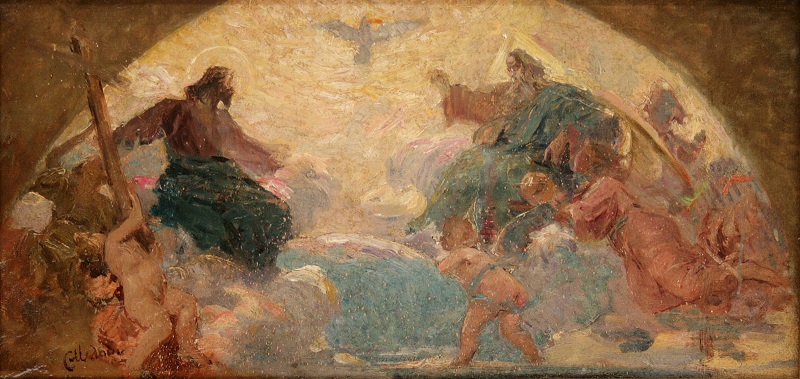
Holy Trinity (sketch for a fresco), 1899., oil on canvas



